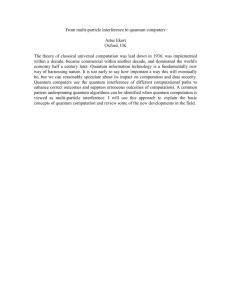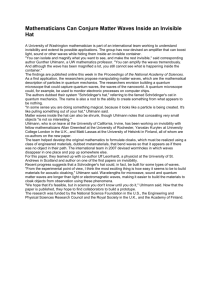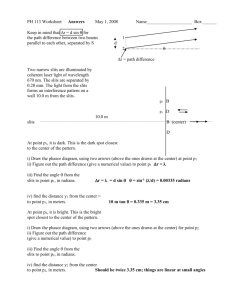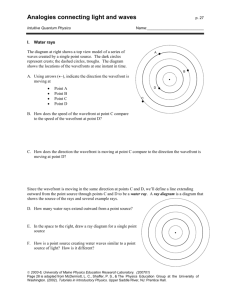Quiz_chapter5
advertisement
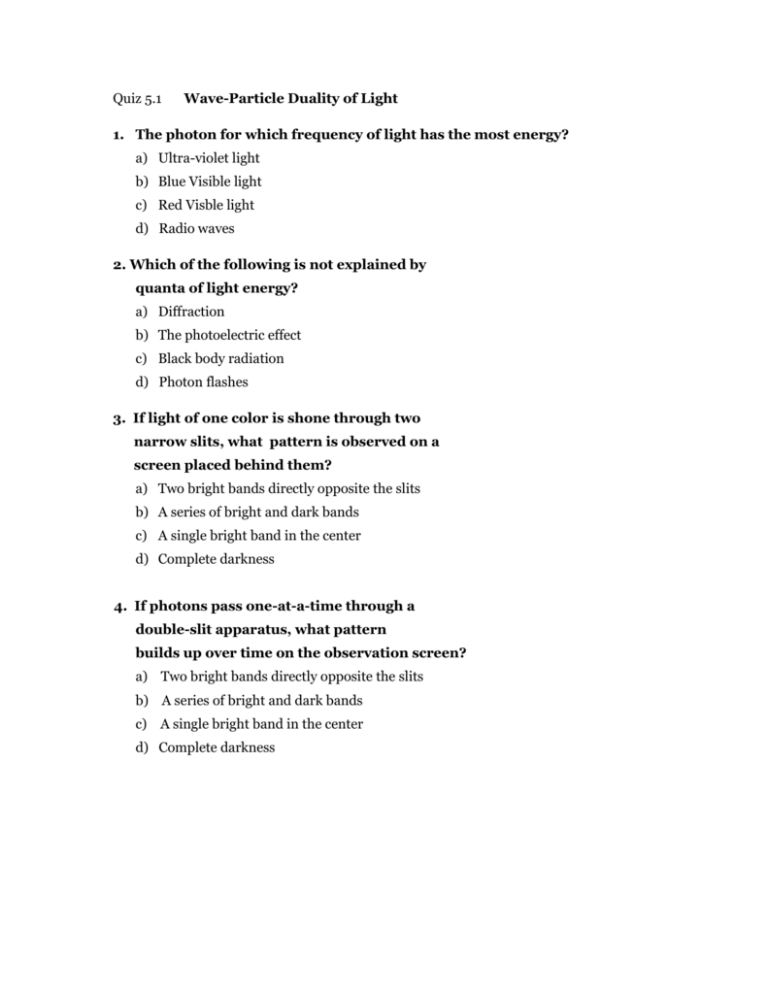
Quiz 5.1 Wave-Particle Duality of Light 1. The photon for which frequency of light has the most energy? a) Ultra-violet light b) Blue Visible light c) Red Visble light d) Radio waves 2. Which of the following is not explained by quanta of light energy? a) Diffraction b) The photoelectric effect c) Black body radiation d) Photon flashes 3. If light of one color is shone through two narrow slits, what pattern is observed on a screen placed behind them? a) Two bright bands directly opposite the slits b) A series of bright and dark bands c) A single bright band in the center d) Complete darkness 4. If photons pass one-at-a-time through a double-slit apparatus, what pattern builds up over time on the observation screen? a) Two bright bands directly opposite the slits b) A series of bright and dark bands c) A single bright band in the center d) Complete darkness Quiz 5.2 Probability & Uncertainty 1. Which best describes the meaning of probability? a) Estimating the outcomes of repeated events b) Measuring the outcomes of repeated events c) Predicting the outcomes of repeated events d) Repeating the outcomes of estimated events 2. Probability of detection in quantum mechanics is represented by wave a) Speed squared b) Height squared c) Frequency squared d) Wavelength squared 3. If one detects which slit a photon goes through during the double-slit experiment, on the observation screen behind the slits a) The interference pattern stays the same b) The interference pattern gets darker c) There is no interference pattern d) The interference pattern gets brighter 4. Which best describes why position and speed cannot both simultaneously be known with arbitrary precious? a) There is always experimental error b) Because simultaneity is relative c) It is difficult to measure very small things d) The measurement of one affects the other Quiz 5.3 Matter Waves 1. De Broglie postulated that a) Matter particles can behave as waves b) Electromagnetic waves can behave as particles c) Photon particles satisfy an uncertainty principle d) Quantum waves satisfy the Schrodinger equation 2. What does Schrodinger’s equation describe the movement of? a) Probability waves b) Water waves c) Sound waves d) Energy waves 3. Electron microscopes see more detail than with visible light because a) Electrons can have shorter wavelengths b) Electrons can have lower speed c) Electrons can have lower momentum d) Electrons can have lower energy 4. “Quantum tunneling” involves a particle in a region where classically a) It would be underground b) It would be with only small probability c) It would create a tunnel in a barrier d) It would not have enough energy to reach Quiz 5.4 Quantum Measurements 1. What is the quantum measurement problem? a) It is difficult to measure small things b) Measurement itself must be described by physics models c) Position and Momentum cannot simultaneously be known precisely d) Physics must be deterministic 2. What happens to a quantum wavefunction in space at the instant of measurement? a) It spreads out over space b) It disappears altogether c) It stays the same d) It collapses to one place 3. Before one looks in the box, Schrodinger’s cat is a) Definitely alive b) Definitely dead c) Neither alive nor dead d) Either alive or dead 4. In the Copenhagen interpretation, quantum mechanical measurement is a) Interaction with a non-quantum measuring instrument b) Splitting of the universe c) Detection of all but hidden variables d) Interaction with a quantum measuring instrument and its environment



